What are the best fish to catch in Florida?
There are plenty of fun and delicious fish to catch in Florida waters. Whatever your target species are, no one ever complains about catching an inshore slam. The slam qualifying species change depending on what part of Florida you are fishing. A few of them are shown below.
To achieve a slam in the North Florida region you will need a redfish, a spotted sea trout and a cobia. The West Florida Coast requires a redfish, a snook and a tarpon. The East Florida Coast requires a redfish, a spotted sea trout and a tarpon. The South Florida region requires a tarpon, a bonefish and a permit.
Many offshore fishermen consider a Pelagic Slam a kingfish, dolphin and a wahoo. AND then there is the slam that I seem to achieve most often. I am referring to the Trashcan Slam which consists of a ladyfish, catfish, jack crevalle or a bluefish.
The article below will cover what are the best fish in Florida to catch based on two main factors:
All of the fish mentioned below are good to eat or good fighters. Some are both.
There are plenty of fun and delicious fish to catch in Florida waters. Whatever your target species are, no one ever complains about catching an inshore slam. The slam qualifying species change depending on what part of Florida you are fishing. A few of them are shown below.
To achieve a slam in the North Florida region you will need a redfish, a spotted sea trout and a cobia. The West Florida Coast requires a redfish, a snook and a tarpon. The East Florida Coast requires a redfish, a spotted sea trout and a tarpon. The South Florida region requires a tarpon, a bonefish and a permit.
Many offshore fishermen consider a Pelagic Slam a kingfish, dolphin and a wahoo. AND then there is the slam that I seem to achieve most often. I am referring to the Trashcan Slam which consists of a ladyfish, catfish, jack crevalle or a bluefish.
The article below will cover what are the best fish in Florida to catch based on two main factors:
- Are they good to eat?
- Are they good fighters?
All of the fish mentioned below are good to eat or good fighters. Some are both.
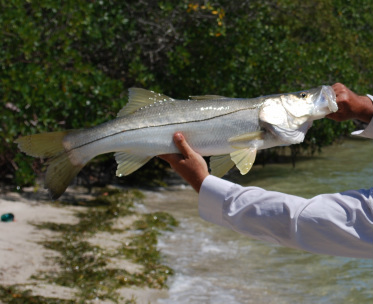
What are the best fish to catch in Florida? Common Snook (aka linesider, robalo)
The snook is one of the most sought after inshore fish in Florida. There are a few different types of snook that can be caught in the waters of Florida. There is the large-scale fat snook, small scale fat snook, swordspine snook, tarpon snook and the common snook.
They are known for their blistering initial run once they realize that they are hooked. Typically, this run will be straight towards structure in an attempt to cut you off.
They are also known for their head shaking jumps when they are smaller. The big ones usually can't get all the way out of the water but will get half way out and shake their heads to dislodge your hook. During the summer, snook will congregate at river mouths, deep passes and the mouths of inlets to spawn. There are times when they stack up like firewood under docks and piers. Learn more about how to catch a snook.
Snook have an odd life cycle. They all begin life as males but once they get about 25+ inches long some go through a sex change and become females. The top of their range on the east coast of Florida is around the Flagler Beach/St. Augustine area depending upon whether it is a cold or warm winter.
During warmer years they can push north a little further but they are not cold weather tolerant. They cannot survive water temperatures below 60 degrees for very long. Snook can also live in fresh water but they are unable to spawn in it and when the many spillways are opened up around central and southern Florida, you can bet that the snook will be waiting for hapless freshwater pan fish to devour.
These fish also make excellent table fare but make sure to check the annually updated saltwater fishing guidelines before keeping one because the size requirements and the opened and closed seasons change quite frequently. A blackened snook sandwich is very tasty but it is not worth losing your flats boat, all of your fishing gear and your freedom for.
See the how to page to learn more.
The snook is one of the most sought after inshore fish in Florida. There are a few different types of snook that can be caught in the waters of Florida. There is the large-scale fat snook, small scale fat snook, swordspine snook, tarpon snook and the common snook.
They are known for their blistering initial run once they realize that they are hooked. Typically, this run will be straight towards structure in an attempt to cut you off.
They are also known for their head shaking jumps when they are smaller. The big ones usually can't get all the way out of the water but will get half way out and shake their heads to dislodge your hook. During the summer, snook will congregate at river mouths, deep passes and the mouths of inlets to spawn. There are times when they stack up like firewood under docks and piers. Learn more about how to catch a snook.
Snook have an odd life cycle. They all begin life as males but once they get about 25+ inches long some go through a sex change and become females. The top of their range on the east coast of Florida is around the Flagler Beach/St. Augustine area depending upon whether it is a cold or warm winter.
During warmer years they can push north a little further but they are not cold weather tolerant. They cannot survive water temperatures below 60 degrees for very long. Snook can also live in fresh water but they are unable to spawn in it and when the many spillways are opened up around central and southern Florida, you can bet that the snook will be waiting for hapless freshwater pan fish to devour.
These fish also make excellent table fare but make sure to check the annually updated saltwater fishing guidelines before keeping one because the size requirements and the opened and closed seasons change quite frequently. A blackened snook sandwich is very tasty but it is not worth losing your flats boat, all of your fishing gear and your freedom for.
See the how to page to learn more.
The video above shows the best lures for catching snook in Florida.
The video above is about Winter Fishing for Snook.
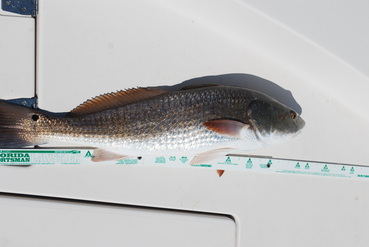
What are the best fish to catch in Florida? Red Drum (red fish)
The red fish or red drum is another amazing fish to catch. These fish are very tough and will give multiple drag screaming runs before tiring out AND they are quite delicious. These fish do not jump but they do pull, pull hard and then pull some more. Reds can get up to about 50 pounds.
Sight fisherman love to target reds because while they are foraging for crabs, fish and invertebrates on the mudflats and around oyster bars they will "tail". You will see their spotted tails above the waterline as they maneuver their bodies to suspend vertically in the water column in search of prey.
They can be very spooky when they are in shallow water so a long cast is a must to maximize your redfish catch. This is when a light braided line outperforms monofilament line by 20 feet or more which can make all the difference. I like a 7-7.5 foot pole with 8 lb braid when targeting slot reds on the flats.
Red fish spawn from August to December. During the spawn is when they earn their true name of red drum. When they are spawning they will advertise their sexuality by rubbing muscles against their air bladders to make their tell tale drumming sound. Learn more about how to catch a redfish.
Red fish can usually be found in small schools. Depending on the time of the year and where you are in Florida, you can find them schooling in huge numbers. Certain times of the year the big bull reds will be cruising the beaches from Jacksonville around the state to Pensacola. At other times they may congregate in inlets and river mouths. It is such a wonderful sight to see the v wakes of a marauding school of reds cruising shallow grass flats in search of prey.
See the how to page to learn more.
The red fish or red drum is another amazing fish to catch. These fish are very tough and will give multiple drag screaming runs before tiring out AND they are quite delicious. These fish do not jump but they do pull, pull hard and then pull some more. Reds can get up to about 50 pounds.
Sight fisherman love to target reds because while they are foraging for crabs, fish and invertebrates on the mudflats and around oyster bars they will "tail". You will see their spotted tails above the waterline as they maneuver their bodies to suspend vertically in the water column in search of prey.
They can be very spooky when they are in shallow water so a long cast is a must to maximize your redfish catch. This is when a light braided line outperforms monofilament line by 20 feet or more which can make all the difference. I like a 7-7.5 foot pole with 8 lb braid when targeting slot reds on the flats.
Red fish spawn from August to December. During the spawn is when they earn their true name of red drum. When they are spawning they will advertise their sexuality by rubbing muscles against their air bladders to make their tell tale drumming sound. Learn more about how to catch a redfish.
Red fish can usually be found in small schools. Depending on the time of the year and where you are in Florida, you can find them schooling in huge numbers. Certain times of the year the big bull reds will be cruising the beaches from Jacksonville around the state to Pensacola. At other times they may congregate in inlets and river mouths. It is such a wonderful sight to see the v wakes of a marauding school of reds cruising shallow grass flats in search of prey.
See the how to page to learn more.
The video above shows you the best lures to catch a redfish in Florida.
The video above is about Winter Fishing For Redfish.
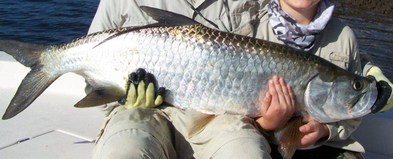
What are the best fish to catch in Florida? Tarpon
Tarpon are also called silver kings as their silver scaled bodies reflect the sunlight so well. Tarpons are known for their numerous jumps once they realize that they are hooked. They are very strong and and have a lot of stamina so get ready for a fight if you are lucky enough to hook one. You may be in for a battle lasting upwards of an hour.
You should not lift the really big ones out of the water because you might harm them and give yourself a hernia in the process. The FWC just came up with a new rule stating that no tarpon over 40 inches in length should be lifted out of the water. The picture above is a quite a few years old.
Tarpon are fresh water tolerant and can breathe air. You will often see them gulp air in waters lacking an adequate diffused oxygen supply. This is why a tarpon can withstand very hot water temperatures going up into the mid 90s. Hot water contains less diffused oxygen than cold water so having the ability to get oxygen from the air is a huge advantage for tarpon. Its takes them up to 13 years to become mature enough to spawn. They travel offshore to spawn between the months of May and September.
They have very hard and bony mouths making it hard to get a decent hook set. Circle hooks work best for me but the gauge should be a thin as you can get away with because it can be hard to puncture their mouths. Big tarpon have snapped my hooks in half before but I would rather have a snapped hook than not get a hook up at all. Learn more about how to catch a tarpon.
The first couple of hours after sunrise and the last couple before sunset are usually the best times of the day to catch a tarpon. Night time can be amazing for tarpon fishermen who are willing to lose sleep for a shot at a monster tarpon.
See the how to page to learn more.
Tarpon are also called silver kings as their silver scaled bodies reflect the sunlight so well. Tarpons are known for their numerous jumps once they realize that they are hooked. They are very strong and and have a lot of stamina so get ready for a fight if you are lucky enough to hook one. You may be in for a battle lasting upwards of an hour.
You should not lift the really big ones out of the water because you might harm them and give yourself a hernia in the process. The FWC just came up with a new rule stating that no tarpon over 40 inches in length should be lifted out of the water. The picture above is a quite a few years old.
Tarpon are fresh water tolerant and can breathe air. You will often see them gulp air in waters lacking an adequate diffused oxygen supply. This is why a tarpon can withstand very hot water temperatures going up into the mid 90s. Hot water contains less diffused oxygen than cold water so having the ability to get oxygen from the air is a huge advantage for tarpon. Its takes them up to 13 years to become mature enough to spawn. They travel offshore to spawn between the months of May and September.
They have very hard and bony mouths making it hard to get a decent hook set. Circle hooks work best for me but the gauge should be a thin as you can get away with because it can be hard to puncture their mouths. Big tarpon have snapped my hooks in half before but I would rather have a snapped hook than not get a hook up at all. Learn more about how to catch a tarpon.
The first couple of hours after sunrise and the last couple before sunset are usually the best times of the day to catch a tarpon. Night time can be amazing for tarpon fishermen who are willing to lose sleep for a shot at a monster tarpon.
See the how to page to learn more.
The video above shows the best lures to catch a tarpon in Florida.
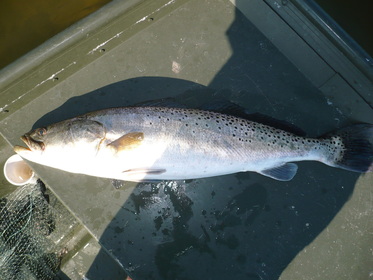
What are the best fish to catch in Florida? Spotted Sea Trout a.k.a. Speckled Trout
Spotted sea trout are very common on the grass flats and oyster bars of Florida. Trout are voracious predators and actively hunt inshore prey like, shrimp and small fish. Usually they are not found too far away from sea grass areas but they will get into deep channels depending upon changes in water temperature. The state record was over 17 pounds and was caught near Ft. Pierce. The typical catch is between 2 to 5 pounds.
These fish are very fragile when they are small and should be handled very carefully once they are caught. Their mouths will also tear very easily so you must be careful not to harm undersized trout. They do not fight very hard until they get around 20 inches in length but they are very good to eat. Their flesh is white and not very fishy. Learn more about how to catch a sea trout.
The larger trout caught around the Treasure Coast of Florida usually have worms in their tail meat. Supposedly, they are a type of tapeworm that lives in sharks. When small fish eat the shark poop the worms make their way through the food chain into the trout. Once the trout is eaten by a shark the cycle begins again. The worms are easy to pick out of the meat and die when cooked just in case you miss one.
The smaller trout (less than 18 inches) usually have very few or no worms. Trout around the Everglades and the West Coast of Florida seem to have less of a worm problem for some reason.
See the how to page to learn more.
Spotted sea trout are very common on the grass flats and oyster bars of Florida. Trout are voracious predators and actively hunt inshore prey like, shrimp and small fish. Usually they are not found too far away from sea grass areas but they will get into deep channels depending upon changes in water temperature. The state record was over 17 pounds and was caught near Ft. Pierce. The typical catch is between 2 to 5 pounds.
These fish are very fragile when they are small and should be handled very carefully once they are caught. Their mouths will also tear very easily so you must be careful not to harm undersized trout. They do not fight very hard until they get around 20 inches in length but they are very good to eat. Their flesh is white and not very fishy. Learn more about how to catch a sea trout.
The larger trout caught around the Treasure Coast of Florida usually have worms in their tail meat. Supposedly, they are a type of tapeworm that lives in sharks. When small fish eat the shark poop the worms make their way through the food chain into the trout. Once the trout is eaten by a shark the cycle begins again. The worms are easy to pick out of the meat and die when cooked just in case you miss one.
The smaller trout (less than 18 inches) usually have very few or no worms. Trout around the Everglades and the West Coast of Florida seem to have less of a worm problem for some reason.
See the how to page to learn more.
The video above shows the best lures to catch a spotted sea trout with.
This video is about catching spotted sea trout in the winter months.
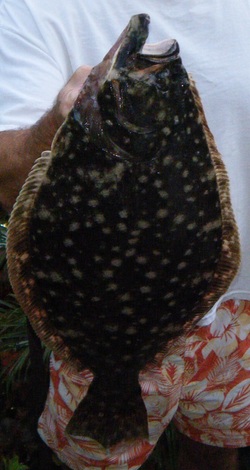
What are the best fish to catch in Florida? Southern Flounder and Gulf Flounder
A flounder is not part of a grand slam but it is another Florida fisherman's favorite because they are delicious and plentiful. They can be found all over the place in Florida waters such as up rivers and canals that lead to salt water; throughout the intracoastal waterways; off of the beaches and inlets.
Typically you will find them near sandy patches in the grass flats; under docks; around near shore reefs or on mud flats and sandbars. They have a very unusual life cycle because they start life like a normal fish with an eye on either side of the head but eventually one eye migrates to the other side of its body.
Flounder are a sight oriented hunter so movement is the key to catching them. They are usually not very picky when it comes to bait preferences. They will hit a jig or feather bounced along the sand. My favorite lure is a gulp shrimp body with a red jig head worked slowly on the bottom. My favorite live bait is a live shrimp under a bobber in water less than 3 feet deep. They love live finger mullet and mud minnows with a sinker on the bottom as well.
Flounder can get pretty big. The Florida state record is over 20 pounds and was caught in Nassau county. The usual size on the flats around the Treasure Coast is about 10 to 15 inches but the inlets usually attract much larger fish. Learn more about how to catch a flounder.
A flounder is not part of a grand slam but it is another Florida fisherman's favorite because they are delicious and plentiful. They can be found all over the place in Florida waters such as up rivers and canals that lead to salt water; throughout the intracoastal waterways; off of the beaches and inlets.
Typically you will find them near sandy patches in the grass flats; under docks; around near shore reefs or on mud flats and sandbars. They have a very unusual life cycle because they start life like a normal fish with an eye on either side of the head but eventually one eye migrates to the other side of its body.
Flounder are a sight oriented hunter so movement is the key to catching them. They are usually not very picky when it comes to bait preferences. They will hit a jig or feather bounced along the sand. My favorite lure is a gulp shrimp body with a red jig head worked slowly on the bottom. My favorite live bait is a live shrimp under a bobber in water less than 3 feet deep. They love live finger mullet and mud minnows with a sinker on the bottom as well.
Flounder can get pretty big. The Florida state record is over 20 pounds and was caught in Nassau county. The usual size on the flats around the Treasure Coast is about 10 to 15 inches but the inlets usually attract much larger fish. Learn more about how to catch a flounder.
The video above shows you the 2 Best lures to catch a flounder with.
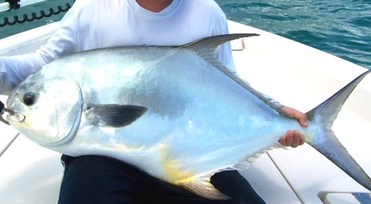
What are the best fish to catch in Florida? Permit
Permit are another inshore fisherman's favorite target species. Permit are one of those fish that lend themselves very well to sight fisherman all around Florida but they are most common in southern Florida waters. These fish often run in schools on very shallow flats searching for crustaceans and other sea creatures in the sea grass. They can also be found offshore around reefs and wrecks.
Permit spawn twice each year. They will spawn during June and July and in the Fall. They have evolved a specialized bony plate at the rear of their mouths which helps them crush and eat hard shelled prey such as crabs and clams. These fish are common under 25 pounds and are members of the jack family.
They are known for their blistering runs once they realize that they are hooked. They do not jump. However, they are an extremely strong pulling fish and have ruined the drag gears of many a fisherman's reels. Permit can grow to more than 50 pounds. The Florida state record is 56 pounds and 2 ounces and was caught around Fort Lauderdale. They usually show up along the Treasure Coast around April as the waters warm up.
See the how to page to learn more.
Permit are another inshore fisherman's favorite target species. Permit are one of those fish that lend themselves very well to sight fisherman all around Florida but they are most common in southern Florida waters. These fish often run in schools on very shallow flats searching for crustaceans and other sea creatures in the sea grass. They can also be found offshore around reefs and wrecks.
Permit spawn twice each year. They will spawn during June and July and in the Fall. They have evolved a specialized bony plate at the rear of their mouths which helps them crush and eat hard shelled prey such as crabs and clams. These fish are common under 25 pounds and are members of the jack family.
They are known for their blistering runs once they realize that they are hooked. They do not jump. However, they are an extremely strong pulling fish and have ruined the drag gears of many a fisherman's reels. Permit can grow to more than 50 pounds. The Florida state record is 56 pounds and 2 ounces and was caught around Fort Lauderdale. They usually show up along the Treasure Coast around April as the waters warm up.
See the how to page to learn more.
The video above shows you the 3 best lures to catch a permit fishing Florida.

What are the best fish to catch in Florida? Cobia
Cobias are another sought after game fish in Florida waters because they are excellent fighters and are very good to eat. Cobia are quite common and can be found in and around the inshore and offshore waters around Florida.
They are voracious predators and will readily eat a live crab, live bait fish or live shrimp offering. They will also hit eel like soft bodied lures. Inshore they can be found trailing large sting rays and manta rays as they scare up food for them out of the grass flats and sand bars. Buoys and channel markers will also attract cobias as they forage for small fish, crabs and shrimp.
Cobias can also be found near shore around floating debris and weed lines. They will also be found on ship wrecks and reefs just offshore. The cobia pictured above is a juvenile and will eventually turn brown with a white underside once mature. Mature cobia spawn in the spring and early summer.
The Florida state record cobia weighed over 130 pounds and was caught near Destin. Cobia are commonly caught in the 20 - 30 pound range.
Cobias are another sought after game fish in Florida waters because they are excellent fighters and are very good to eat. Cobia are quite common and can be found in and around the inshore and offshore waters around Florida.
They are voracious predators and will readily eat a live crab, live bait fish or live shrimp offering. They will also hit eel like soft bodied lures. Inshore they can be found trailing large sting rays and manta rays as they scare up food for them out of the grass flats and sand bars. Buoys and channel markers will also attract cobias as they forage for small fish, crabs and shrimp.
Cobias can also be found near shore around floating debris and weed lines. They will also be found on ship wrecks and reefs just offshore. The cobia pictured above is a juvenile and will eventually turn brown with a white underside once mature. Mature cobia spawn in the spring and early summer.
The Florida state record cobia weighed over 130 pounds and was caught near Destin. Cobia are commonly caught in the 20 - 30 pound range.
The video above shows you the 3 best lures to catch a cobia fishing in Florida.
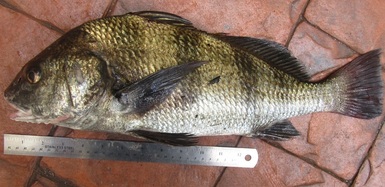
What are the best fish to catch in Florida? Black Drum
Black drums are another delicious member of the drum family which includes redfish, croakers and spotted sea trout. Black drums are very common inshore and along the beaches in Florida waters. They can often be found in large schools as they forage for shrimp, crabs, mussels, clams and oysters.
They can usually be found near oyster beds and are a bottom dwelling fish. Just under their chins are about a dozen sensitive barbels that they use to detect prey in murky waters. Their teeth are hard plates made for crushing the hard shells of oysters, clams and crabs. Black drums are often mistaken for a sheepshead but usually have more faded black lines and are more oblong in body shape. Learn more about how to catch a black drum.
Black drums are the largest of the drum family. The Florida state record was caught near Fernandina Beach and weighed 96 pounds. Black drum can often be seen tailing in shallow water as they search for crustaceans in and around oyster bars. When you see a tailing black drum, toss a shrimp, crab or a clam strip in front of them and hold on. Black drums will also hit lures like a gold spoon, scented jig and even a spinner bait worked slowly in from of them.
Black drums are another delicious member of the drum family which includes redfish, croakers and spotted sea trout. Black drums are very common inshore and along the beaches in Florida waters. They can often be found in large schools as they forage for shrimp, crabs, mussels, clams and oysters.
They can usually be found near oyster beds and are a bottom dwelling fish. Just under their chins are about a dozen sensitive barbels that they use to detect prey in murky waters. Their teeth are hard plates made for crushing the hard shells of oysters, clams and crabs. Black drums are often mistaken for a sheepshead but usually have more faded black lines and are more oblong in body shape. Learn more about how to catch a black drum.
Black drums are the largest of the drum family. The Florida state record was caught near Fernandina Beach and weighed 96 pounds. Black drum can often be seen tailing in shallow water as they search for crustaceans in and around oyster bars. When you see a tailing black drum, toss a shrimp, crab or a clam strip in front of them and hold on. Black drums will also hit lures like a gold spoon, scented jig and even a spinner bait worked slowly in from of them.
The video above shows you the best 2 lures to catch black drum fishing Florida.
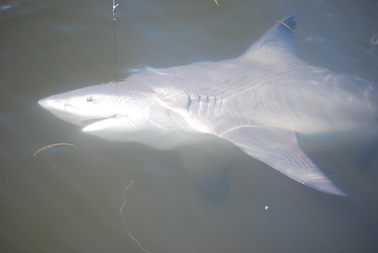
What are the best fish to catch in Florida? Sharks
There are plenty of different species of sharks in Florida. You can catch bull sharks, lemon sharks, blacktip sharks, spinner sharks, hammerhead sharks, mako sharks...... Regardless of the shark species that you are trying to catch they all have two things in common. They all like to eat and they all put up extraordinary fights. Four hundred million years of evolution has created the perfect marine predator.
In Florida, you can find sharks in the surf all of the time. Just sink a big piece of ladyfish, mullet or jack crevalle and hold on. You usually will not have to wait very long. During the winter shark migration between November and April thousands of sharks travel between Jacksonville down to Miami and back. During this time of year, catching a shark off of the beach is a layup.
When fishing inshore, look for a river mouth or the combination of a shallow mudflat or sandbar that is accompanied by a deep drop off. This seems to be a favorite hunting spot for sharks and other large predators like tarpon. Learn more about how to catch a shark.
Blacktips are the most common shark in Florida and one of the most fun to catch. Blacktip sharks and spinner sharks will usually jump a few times when hooked. Sharks like bull sharks, lemon sharks and sandbar sharks will usually just pull without a jump. Sharks are one of the strongest and hardest fighting fish that you will catch. A big one can strip your reel's gears out very quickly.
There are plenty of different species of sharks in Florida. You can catch bull sharks, lemon sharks, blacktip sharks, spinner sharks, hammerhead sharks, mako sharks...... Regardless of the shark species that you are trying to catch they all have two things in common. They all like to eat and they all put up extraordinary fights. Four hundred million years of evolution has created the perfect marine predator.
In Florida, you can find sharks in the surf all of the time. Just sink a big piece of ladyfish, mullet or jack crevalle and hold on. You usually will not have to wait very long. During the winter shark migration between November and April thousands of sharks travel between Jacksonville down to Miami and back. During this time of year, catching a shark off of the beach is a layup.
When fishing inshore, look for a river mouth or the combination of a shallow mudflat or sandbar that is accompanied by a deep drop off. This seems to be a favorite hunting spot for sharks and other large predators like tarpon. Learn more about how to catch a shark.
Blacktips are the most common shark in Florida and one of the most fun to catch. Blacktip sharks and spinner sharks will usually jump a few times when hooked. Sharks like bull sharks, lemon sharks and sandbar sharks will usually just pull without a jump. Sharks are one of the strongest and hardest fighting fish that you will catch. A big one can strip your reel's gears out very quickly.
The video above shows you how to catch sharks using topwater lures.
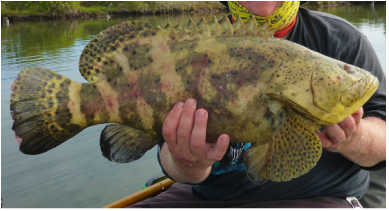
What are the best fish to catch in Florida? Grouper
Grouper are one of those delicious fish that are usually fished for offshore around deep water wrecks, reefs and rock piles but there are lots of smaller grouper inshore. They can be found in tidal creeks, around bridge pilings, under docks, in inlets, on the grass flats...... The bottom line to catch grouper is to find underwater structure where they feel safe and can lie in wait for passing prey. They will usually be backed into some kind of hole or right at the entrance of their hole facing into the current.
There are many types of grouper that fishermen can target inshore. The Goliath grouper is the largest grouper species and can grow to 800 pounds. There probably is not enough forage to keep a 800 lb. grouper on a grass flat or anywhere inshore but there is enough to keep a 50 lb. grouper happy in shallow inshore waters. Goliath groupers have been protected since the 1990's and are very prevalent. There are also gag groupers and red groupers that can be easily caught in and around inlets and under bridges all around Florida.
*You should never lift a large Goliath grouper out of the water. It can cause internal damage to the fish. The grouper in the picture above is probably the maximum size that can be safely unhooked out of the water and released without harm. Learn more about how to catch a grouper.
Groupers are very aggressive predators and will hit just about anything that you get near their holes where they reside. A lipped diving lure works well in waters 30 feet or less. Vertical jigging a scented jig or a jig tipped with a piece of shrimp, fish or squid also works very well to catch groupers. Silver and gold spoons will also catch their fair share of grouper inshore.
A live mullet, pinfish, ladyfish or just about any other prey fished with a sinker to get it down to where the grouper are will usually not be ignored. Heavy tackle is often necessary to get a grouper up and out of its protective hole once hooked so be ready to reel as soon as you feel the hit.
Grouper are one of those delicious fish that are usually fished for offshore around deep water wrecks, reefs and rock piles but there are lots of smaller grouper inshore. They can be found in tidal creeks, around bridge pilings, under docks, in inlets, on the grass flats...... The bottom line to catch grouper is to find underwater structure where they feel safe and can lie in wait for passing prey. They will usually be backed into some kind of hole or right at the entrance of their hole facing into the current.
There are many types of grouper that fishermen can target inshore. The Goliath grouper is the largest grouper species and can grow to 800 pounds. There probably is not enough forage to keep a 800 lb. grouper on a grass flat or anywhere inshore but there is enough to keep a 50 lb. grouper happy in shallow inshore waters. Goliath groupers have been protected since the 1990's and are very prevalent. There are also gag groupers and red groupers that can be easily caught in and around inlets and under bridges all around Florida.
*You should never lift a large Goliath grouper out of the water. It can cause internal damage to the fish. The grouper in the picture above is probably the maximum size that can be safely unhooked out of the water and released without harm. Learn more about how to catch a grouper.
Groupers are very aggressive predators and will hit just about anything that you get near their holes where they reside. A lipped diving lure works well in waters 30 feet or less. Vertical jigging a scented jig or a jig tipped with a piece of shrimp, fish or squid also works very well to catch groupers. Silver and gold spoons will also catch their fair share of grouper inshore.
A live mullet, pinfish, ladyfish or just about any other prey fished with a sinker to get it down to where the grouper are will usually not be ignored. Heavy tackle is often necessary to get a grouper up and out of its protective hole once hooked so be ready to reel as soon as you feel the hit.
The video above shows you the 3 best lures to catch grouper inshore.
The video above shows you how to make your own DIY grouper jigs.

Send us your photos.
Be part of Team Salt Donkey and send us your fishing photos for publication on our website and Facebook page. Send photos to photos@fishyourassoff.com. Images must not have appeared or been submitted elsewhere.
Make sure to include the names of the people pictured, location of catch, details (ie. it took an hour to reel in; it weighed 100 lbs.; it was at dead low tide...) and the bait and tackle used.
Be part of Team Salt Donkey and send us your fishing photos for publication on our website and Facebook page. Send photos to photos@fishyourassoff.com. Images must not have appeared or been submitted elsewhere.
Make sure to include the names of the people pictured, location of catch, details (ie. it took an hour to reel in; it weighed 100 lbs.; it was at dead low tide...) and the bait and tackle used.
